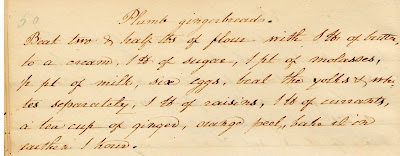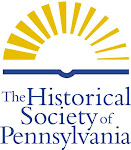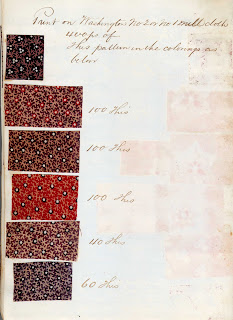
The Historical Society also owns Martha Washington's Cook Book. Last June we had a Solstice Potluck with staff and interns using the recipes from Mrs. Washington's book. It was quite successful and we've been anticipating the second annual potluck all winter. But perhaps the format will need to change in honor of the Chews the year?
The cookbooks are interesting to compare. Both are written by one writer and were started at both ends. Each has interesting instructions and measurements. For example, Elizabeth has a recipe for Morning Rolls, which calls for "a piece of butter the size of an egg and a 1/2." However, Mrs. Washington's book was clearly written before foods of the new world became part of the diet. There is no mention of tomatoes, potatoes, or squash. Her book is also organized into two sections; one of "cookery" and one of "sweetmeats." Elizabeth's book is full of food from the new world including recipes for catsup of tomatoes and of mushrooms, and references for straining things "as you would for squash." There does not seem to be a logical organization of Elizabeth's book.

Some of the more fun recipes include the "Kisses" above, and the Plumb Gingerbread. Although we have yet to find the plumbs in the gingerbread.

There are interesting recipes for Pickled Walnuts, and sevreal recipes for oysters, (boiled, fried, baked, or as a pie). A few of the eyebrow-raising items include: "Oily Mixture" and one "To Turtle Calves Head."

Along with recipes written down, there are a few dozen given to her by others, hastily written on scraps of paper or cut from the newspaper. She has several for Summer Complaint; this one sounds the yummiest - while others call for Gum Arabic and Laudanum.

And finally, one of the more interesting recipes to compare directly with Mrs. Washington's book is for Tomato Tart.
 Without a doubt, the favorite surprise success recipe at last year's potluck was Mrs. Washington's Lettuce Pie. While the recipe sounded easy none of us trusted it to be any good. But Annie put it together it was the hit of the day. I suspect this one could be quite tasty with homegrown tomatoes completely ripened. I also suspect that it could inspire a very nice savory tart as well.
Without a doubt, the favorite surprise success recipe at last year's potluck was Mrs. Washington's Lettuce Pie. While the recipe sounded easy none of us trusted it to be any good. But Annie put it together it was the hit of the day. I suspect this one could be quite tasty with homegrown tomatoes completely ripened. I also suspect that it could inspire a very nice savory tart as well.






